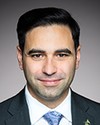Thank you very much, Madam Chair.
Good morning, committee members, and Ms. Hogan, Mr. Jones and Madam Brassard.
Thank you to the committee for the invitation.
Before I begin, I'd like to acknowledge that I'm participating today from Ottawa, the traditional territory of the Anishinabe and Algonquin nations.
I am pleased to be here on behalf of Ms. Nancy Gardiner, as the acting president of the Federal Economic Development Agency for Southern Ontario—or FEDAV Ontario, as it's known—to participate in your study on report 14, “Regional Relief and Recovery Fund”.
I'm joined today by my colleague, Linda Cousineau, vice-president, business innovation and community development.
FedDev Ontario is the regional development agency responsible for managing the RRRF in southern Ontario.
At the outset of the pandemic, when it became clear how badly Canadian businesses and communities would be impacted by restrictions to keep Canadians safe, Canada’s regional development agencies, or RDAs, quickly pivoted to design and deliver the RRRF.
This fund was a critical federal tool to help businesses and organizations mitigate pandemic-related financial pressures. It also provided an important backstop to other federal business supports, such as the wage and rent subsidies and the Canada emergency business account.
We thank the Auditor General for her work and the work of her team. We are pleased to see the recognition that the RRRF's design aligned with the government's objectives for helping businesses and organizations deal with the impact of the pandemic and addressed gaps not covered by other COVID-related programs.
The report also acknowledged that leveraging existing experience and systems, as well as the direction to accept greater risks, allowed the RDAs to design and deploy the program within weeks of the onset of the pandemic.
Southern Ontario is a key driver of Canada's economic growth, representing more than 39% of the country's GDP and employment. However, the region was hard hit by the pandemic. More than a million jobs were lost in southern Ontario by April 2020. To provide critical support to small businesses and their employees when it was needed most, FedDev Ontario was allocated more than $500 million to deliver the RRRF in southern Ontario.
FedDev Ontario’s direct delivery of RRRF provided relief to more than 1,300 businesses across the region.
We also worked with Community Futures Development Corporations, or CFDCs, to provide targeted relief to more than 1,950 rural small businesses.
In addition, to maximize the program’s reach and impact, we worked with regional partners to provide targeted support that reached more than 39,000 small businesses, including sectors hardest hit by the pandemic, as well as under-represented groups that were disproportionately affected.
Overall results for the RRRF in southern Ontario show that funding was provided to businesses that needed it most, with almost $160 million supporting southern Ontario's tourism businesses, surpassing the commitment to provide at least 25% of RRRF funds to the hardest-hit tourism sector; more than $150 million supporting women-owned or women-operated businesses; $10 million supporting indigenous businesses; and more than $140 million supporting rural areas.
The Auditor General's report noted that overall, the RRRF was successful at providing last-resort assistance to thousands of businesses and organizations affected by the COVID-19 pandemic.
Work is under way to address each of the recommendations, and the audited RDAs have developed a detailed response and action plan.
We have taken steps to continue to look for ways to better support under-represented groups. For example, based on a GBA+ analysis, dedicated funding was set aside for indigenous businesses under the tourism relief fund. Activities that foster inclusive recovery are also being prioritized in the delivery of the jobs and growth fund.
We agree that it would be helpful to examine practical ways to improve transparency in the future and, when appropriate, leverage common regional development agency approaches to program delivery, assessment and approval.
RDAs were established to be place-based and reflective of the regions they serve. Delivery of national programs by RDAs should of course be coordinated, but also delivered in a way that reflects each regions’ unique needs and circumstances.
Harmonizing processes to accurately report on program outcomes is an area for further improvement. Lessons learned from the RRRF will inform the design of performance measurement strategies for future initiatives.
Since spring 2021, all new initiatives delivered by multiple RDAs have been developed to foster harmonization of program indicators and the collection of data.
Under the leadership of Minister Jaczek, FedDev Ontario will work with its RDA colleagues to take the lessons from the delivery of the RRRF during this unprecedented time to refine and improve its approaches to supporting businesses and organizations in the regions.
In closing, Madam Chair, I'd like to acknowledge the efforts of the public servants within our organization to quickly design and deliver this program while themselves navigating a once-in-a-generation pandemic. During an extraordinary and uncertain period, they successfully worked together to provide timely support that helped to make sure that businesses could keep operating and employing Canadians.
Thank you.



